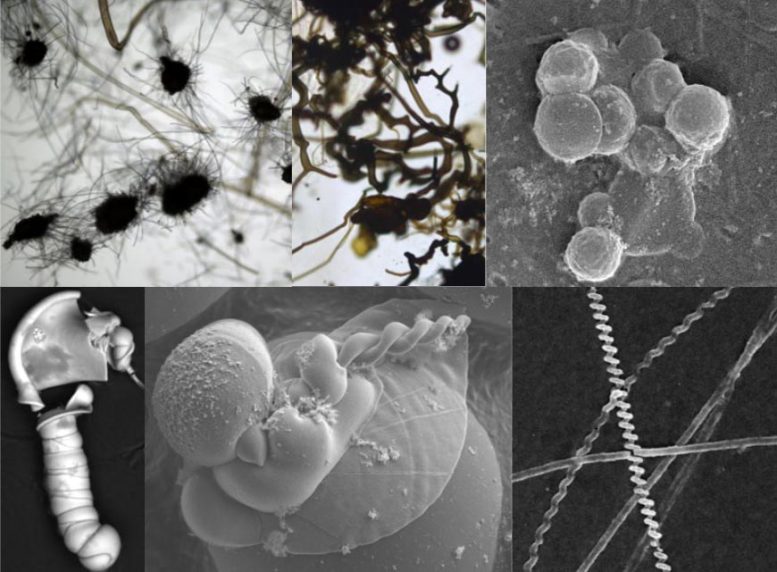
Chemical processes on Mars can mimic fossils, complicating the search for ancient life and demanding careful, interdisciplinary analysis.
Mars explorers searching for signs of ancient life could be fooled by fossil-like specimens created by chemical processes, research suggests.
Rocks on Mars may contain numerous types of non-biological deposits that look similar to the kinds of fossils likely to be found if the planet ever supported life, a study says.
Telling these false fossils apart from what could be evidence of ancient life on the surface of Mars – which was temporarily habitable four billion years ago – is key to the success of current and future missions, researchers say.
Astrobiologists from the Universities of Edinburgh and Oxford reviewed evidence of all known processes that could have created lifelike deposits in rocks on Mars.
They identified dozens of processes – with many more likely still undiscovered – that can produce structures that mimic those of microscopic, simple lifeforms that may once have existed on Mars.
Among the lifelike specimens these processes can create are deposits that look like bacterial cells and carbon-based molecules that closely resemble the building blocks of all known life.
The Challenge of Ambiguous Origins
Because signs of life can be so closely mimicked by non-living processes, the origins of any fossil-like specimens found on Mars are likely to be very ambiguous, the team says.
They call for greater interdisciplinary research to shed more light on how lifelike deposits could form on Mars, and thereby aid the search for evidence of ancient life there and elsewhere in the solar system.
The research is published in the Journal of the Geological Society.
Dr. Sean McMahon, Chancellor’s Fellow in Astrobiology at the University of Edinburgh’s School of Physic and Astronomy, said: “At some stage a Mars rover will almost certainly find something that looks a lot like a fossil, so being able to confidently distinguish these from structures and substances made by chemical reactions is vital. For every type of fossil out there, there is at least one non-biological process that creates very similar things, so there is a real need to improve our understanding of how these form.”
Julie Cosmidis, Associate Professor of Geobiology at the University of Oxford, said: “We have been fooled by life-mimicking processes in the past. On many occasions, objects that looked like fossil microbes were described in ancient rocks on Earth and even in meteorites from Mars, but after deeper examination they turned out to have non-biological origins. This article is a cautionary tale in which we call for further research on life-mimicking processes in the context of Mars, so that we avoid falling into the same traps over and over again.”
Reference: “False biosignatures on Mars: anticipating ambiguity” by Sean McMahon and Julie Cosmidis, 17 November 2021, Journal of the Geological Society.
DOI: 10.1144/jgs2021-050
Never miss a breakthrough: Join the SciTechDaily newsletter.
5 Comments
Oh for f*@ks sake. Could you be any more obvious in your wild grasping for grant money? NASA is broke. Go work for some chemical company and help poison the world. The rest of your buddies did.
Could you be any more obvious in your wild grasping for concern trolling irrelevancies? NASA has a steady budget thanks to its steady results, and few physicists work for chemical companies anyway. (Which companies, I note, mostly do not produce specifically poisonous agents. Just sayin’.)
Wait. Chemical reactions can make some fossil like things. Interesting
So they still haven’t even found microbial life yet.
Even if they do it could’ve come from earth after asteroid impacts and changed overtime.
If we find living crustal life you would know about it! It would be all over media.
And if we do we could sequence its genetic material and look for homologies and, if there was a common ancestor, the age of the split.
Fossils are harder.
Unmentioned here is that due to known abiotic confounds various trace and micro fossils have to undergo a long series of methodical tests to be accepted. The results here underscore the necessity of this methodology.
A curious note is that IIRC the first natural hypotheses for evolution of early life were inspired by and modelled on chemical gardens.
“But, if we enter analysis of any potential microfossils on Mars knowing the processes that can produce pseudofossils, we have a better chance of accurately interpreting what we’re seeing.
Many physical processes associated with weathering and the depositing of sedimentary layers can produce rocks that look eerily like fossils.
Another mechanism is the chemical garden, in which chemicals mixing can produce structures that look biological. Many different types of minerals can also combine to produce pseudofossils known as biomorphs, which look strikingly biological.”
[ https://www.sciencealert.com/false-fossils-could-confuse-the-search-for-life-on-mars ]